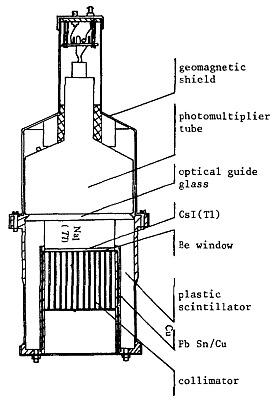Purpose of the flight and payload description
HAPI-2 was a balloon-borne hard X-ray phoswich telescope, a modified version of the earlier HAPI-1 system. It was designed by the Institute of High Energy Physics, Chinese Academy of Sciences for the observation of cosmic X-ray sources in the energy range of 20 to 200 keV.
The detector which can be seen in the image at left, comprised two scintillating crystal layers: a thin 0.4 cm CsI(Tl) layer with a detection area of 140 cm² and a thicker 5 cm NaI(Tl) layer with a diameter of 15 cm. This combination allowed for effective discrimination between different types of incoming radiation. Surrounding the detector was a passive graded shield constructed from lead (5 mm), tin (2 mm), and copper (1 mm), which minimized background noise from non-X-ray sources. The collimator, formed by layered sheets of tungsten, tin, and copper, provided an aperture of 6.0° x 6.0° (Full Width at Half Maximum), thereby defining the telescope's field of view.
The electronic system of the detector, supported by a telemetry link and a ground-based microcomputer, enabled real-time measurements of photon arrival times with a precision of 0.1 seconds. The energy loss within the main detector was recorded with 8-bit analog-to-digital conversion and stored event-by-event onto disk without interruption. Extensive pre-flight calibrations, including those for angular response, peak efficiency, energy resolution, and pointing accuracy, were carried out to ensure the fidelity of in-flight data.
The pointing system of the instrument had a stability of ±0.1° and a pointing accuracy of ±0.2°, with adjustable speeds of 0.3° per second in both elevation and azimuth.
Details of the balloon flight
Balloon launched on: 9/22/1985
Launch site: Xiang He Balloon Launch Center, Hebei, China
Balloon launched by: Institute of High Energy Physics (IHEP)
Balloon manufacturer/size/composition: Zero Pressure Balloon 100.000 m3
End of flight (L for landing time, W for last contact, otherwise termination time): 9/22/1985
The balloon was launched from the Xianghe balloon station in Hebei Province at 9:13 utc on September 22 May, 1985. After a nominal ascent phase, it reached a float stable altitude of 38 km.
During the flight, adjustments to the telescope's azimuth and elevation were made every four minutes to maintain alignment with the target, Cyg X-1, allowing it to remain within ±0.5° of the telescope's central axis and ensuring that over 90% of the effective exposure area was utilized. For background measurements, the telescope was directed close to but clear of other known X-ray sources. All operations and adjustments were carefully coordinated and executed using real-time ground control inputs.
External references
- A Hard X-Ray Observation of CYG X-1 in 1985 The Origin and Evolution of Neutron Stars; Proceedings of the IAU Symposium, Nanjing, People's Republic of China, May 26-30, 1986
- The energy spectrum of Cygnus X-1 Chinese Astronomy and Astrophysics, Vol. 14, Issue 1, March 1990, Pag. 1
2269If you consider this website interesting or useful, you can help me to keep it up and running with a small donation to cover the operational costs. Just the equivalent of the price of a cup of coffee helps a lot.


